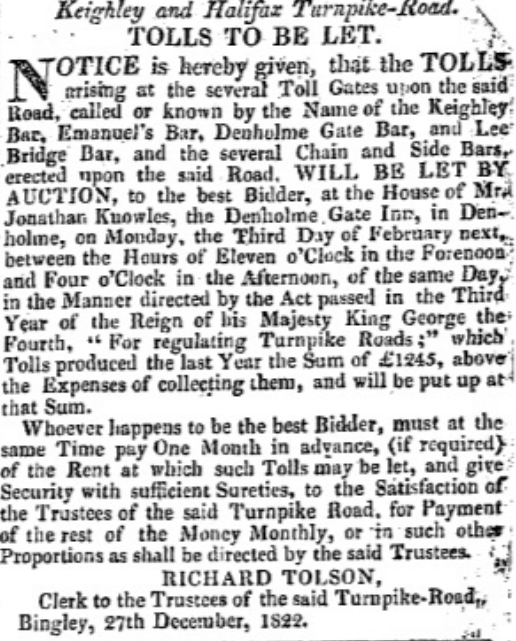Under an Act of Parliament of 1555 responsibility was laid on each parish vestry to maintain all its roads. The parish vestry meeting, though it might meet in a church vestry was about the civil parish, not the church parish. It was made up of landowners within a parish.
Parishioners and tenants had to provide 4 days labour each every year to actually work themselves on the repair of the roads or pay for a substitute to do the work. Landowners had to provide stone and other materials. The 4 days was extended to 6 days each every year in 1562. This arrangement was adequate for roads that the parishioners used themselves but proved unsatisfactory for the principal highways that were used by long-distance travellers and waggoners.
People were loath to be responsible for improvements to a road passing through their village if the only beneficiaries were strangers making their way to a distant town. Long journeys were not only made hazardous by the conditions of the roads but also by the chance of being held up by highwaymen. The 6 day law ceased in the 1765.
Turnpike Acts authorised a trust to levy tolls on those using the road and to use that income to repair and improve the road. They could also purchase property to widen or divert existing roads. The trusts were not-for-profit and maximum tolls were set. The income not only paid for the cost of the road and its upkeep but enabled dividends to shareholders. The ‘turnpike’ was the gate which blocked the road until the toll was paid.
There were 3 Turnpike Trusts in our area each created by an Act of Parliament
Keighley and Halifax Act of 1753, along the line of what is now the A629.
Brighouse and Denholme Gate Act of 1825 The Gate of Denholme Gate refers to a gate to the mediaeval Denholme deer park. That Turnpike Trust built Brighouse and Denholmegate Road, now the A644/
Bradford and Thornton Act of 1825. Towards Thornton the main road from Bradford had previously been winding, following the current roads from Mumby Street now named Thornton Old Road which ran through to Leaventhorpe Lane, which came out directly outside Leaventhorpe Hall then followed Old Road which continued across part of the housing estate to what are now Brontë Old Road and Market Street, down Kipping Lane to Lower Kipping Lane and Alderscholes Lane to Squirrell and beyond. In 1825 these roads were very much just dirt tracks with neither foundations nor drainage. The turnpike road from Bradford to Leaventhorpe Hall was built, and opened, in 1826. The turnpike road from Leaventhorpe Hall to the Keighley and Halifax turnpike was not built until 1829. See a transcript of an advert from the Leeds Mercury of 29 January 1829:
TO ROAD MAKERS. – TO BE LET BY TICKET, at the House of Thomas Scott, the New Inn, in Thornton, on Monday, the Sixteenth Day of February next, at Three o’Clock in the Afternoon, the COMPLETION of the BRADFORD and THORNTON TURNPIKE ROAD from the Junction with the Old Highway near Leaventhorp Hall to the Termination at Sun Side Cottages, about Three Miles in Length. Plans, Sections, and Specifications may be seen on Application to Mr. G.T.Lister, Bradford.
The image taken from the 6″ Ordnance Survey map of 1847 shows where the Leaventhorpe Toll Bar was (T.P, on the map), as well as the old road coming in front of Leaventhorpe Hall, and the row of terrace houses called Bricks.

It’s interesting to note that the New Inn is mentioned. I now believe this to be a typographical error. There was a New Inn in Bradford, on Thornton Road, where the Turnpike Trust held its annual meetings. In Thornton itself the Turnpike Trust road was referred to as the New Road.
Every year the Trust let out, to the highest bidder, the maintenance of the road and collection of the tolls, as in the advertisement from the Leeds Mercury of 18 January 1823.

The Bradford Observer of the 26 December 1836 includes the following letter about the state of the Turnpike Road:

The Bradford and Thornton Turnpike Trust ceased to exist in 1861 due to bad debts.
Few signs of the Turnpike Roads remain, except the roads themselves. There is what looks like a Toll house at Keelham cross roads, the house with an odd window jutting out onto the pavement.
After passing the former parish church the road towards Denholme bends and then goes downhill. Approximately half way down, on the left, is this milestone. It is a Grade 2 listed monument. See the photo.

Turnpikes declined with the coming of the railways and then the Local Government Act 1888 gave responsibility for maintaining main roads to county councils and county borough councils.
The legacy of the turnpike trust is the network of roads that still form the framework of the main road system in Britain. In addition, many roadside features such as milestones and tollhouses, have survived, despite no longer having any function in the modern road management system.
(Last updated 3 November 2023)
© Clive Richardson. May be copied, with attribution, for non-commercial purposes.